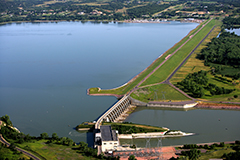Gavins Point Dam
Gavins Point Dam is a large embankment rolled-earth and chalk-fill dam on the Missouri River located in both Nebraska and South Dakota in the Upper Midwest Region of the United States. The dam and hydroelectric power plant were constructed as the Gavins Point Project from 1952 to 1957 by the United States Army Corps of Engineers. The dam creates the 31,400 acre (12,700 ha) Lewis and Clark Lake and is located approximately 4 miles west (6.4 km) (upstream) of Yankton, South Dakota.
 Gavins Point Dam was constructed as a part of the Pick–Sloan Missouri Basin Program, authorized by the Flood Control Act of 1944 by Congress. The dam is named after "Gavins Point", a bluff along the Missouri River named for an early settler, now within the western end of Lewis & Clark Recreation Area, which was to be the original location of construction of the dam. The location was moved and construction began further downstream along Calumet Bluff because this location offered a shorter span distance and less fill material needed for dam construction, although the project kept the original name.
Gavins Point Dam was constructed as a part of the Pick–Sloan Missouri Basin Program, authorized by the Flood Control Act of 1944 by Congress. The dam is named after "Gavins Point", a bluff along the Missouri River named for an early settler, now within the western end of Lewis & Clark Recreation Area, which was to be the original location of construction of the dam. The location was moved and construction began further downstream along Calumet Bluff because this location offered a shorter span distance and less fill material needed for dam construction, although the project kept the original name.
The dam has a hydroelectric power plant with three generators, each having a nameplate capacity of 44,099 kW, for a total of 132.297 MW. The hydroelectric power plant provides enough electricity to supply 68,000 homes. Power generated is sold through the Western Area Power Administration.
Gavins Point Dam creates Lewis and Clark Lake, a popular regional tourist destination for water-based recreational opportunities including boating and fishing, along with camping, hiking, and hunting opportunities managed by the State of South Dakota, State of Nebraska, and the U.S. Army Corps of Engineers (USACE). The lake is significantly impacted by sedimentation and siltation issues, diminishing the overall water surface area, water storage capacity, and recreational opportunities. More details
 Gavins Point Dam was constructed as a part of the Pick–Sloan Missouri Basin Program, authorized by the Flood Control Act of 1944 by Congress. The dam is named after "Gavins Point", a bluff along the Missouri River named for an early settler, now within the western end of Lewis & Clark Recreation Area, which was to be the original location of construction of the dam. The location was moved and construction began further downstream along Calumet Bluff because this location offered a shorter span distance and less fill material needed for dam construction, although the project kept the original name.
Gavins Point Dam was constructed as a part of the Pick–Sloan Missouri Basin Program, authorized by the Flood Control Act of 1944 by Congress. The dam is named after "Gavins Point", a bluff along the Missouri River named for an early settler, now within the western end of Lewis & Clark Recreation Area, which was to be the original location of construction of the dam. The location was moved and construction began further downstream along Calumet Bluff because this location offered a shorter span distance and less fill material needed for dam construction, although the project kept the original name.The dam has a hydroelectric power plant with three generators, each having a nameplate capacity of 44,099 kW, for a total of 132.297 MW. The hydroelectric power plant provides enough electricity to supply 68,000 homes. Power generated is sold through the Western Area Power Administration.
Gavins Point Dam creates Lewis and Clark Lake, a popular regional tourist destination for water-based recreational opportunities including boating and fishing, along with camping, hiking, and hunting opportunities managed by the State of South Dakota, State of Nebraska, and the U.S. Army Corps of Engineers (USACE). The lake is significantly impacted by sedimentation and siltation issues, diminishing the overall water surface area, water storage capacity, and recreational opportunities. More details
